The Dualism of Good and Evil in “Young Goodman Brown” and “Rappaccini’s Daughter”
Main Article Content
บทคัดย่อ
The difficulty of retaining one’s faith in a world notable for its ambiguous mixture of good and evil is the common theme that relates two of Hawthorne’s famous short stories, “Young Goodman Brown” and “Rappaccini’s Daughter.” Hawthorne believes that in order to find a hope of heaven—in order, that is, to develop one’s full human potential—man must accept the tragic involvement with sin, but also the consequent possibility of redemption (Male, 2005, p. 54). In both “Young Goodman Brown” and “Rappaccini’s Daughter”, this perplexing amalgamation of vice and virtue is clearly illustrated in the settings and the characterization of the women.
Article Details
รูปแบบการอ้างอิง
Chareanpunsirikul, N. (2015). The Dualism of Good and Evil in “Young Goodman Brown” and “Rappaccini’s Daughter”. วารสารรามคำแหง ฉบับมนุษยศาสตร์, 29(1), 185–190. สืบค้น จาก https://so05.tci-thaijo.org/index.php/huru/article/view/27875
ประเภทบทความ
บทความวิชาการ

อนุญาตภายใต้เงื่อนไข Creative Commons Attribution-NonCommercial-NoDerivatives 4.0 International License.
ประกาศลิขสิทธิ์จะปรากฏในเกี่ยวกับวารสาร ควรอธิบายสำหรับผู้อ่านและผู้เขียนว่าเจ้าของลิขสิทธิ์เป็นผู้เขียนวารสารหรือบุคคลที่สาม ควรรวมถึงข้อตกลงการอนุญาตเพิ่มเติม (เช่นใบอนุญาตครีเอทีฟคอมมอนส์) ที่ให้สิทธิ์แก่ผู้อ่าน (ดูตัวอย่าง) และควรให้วิธีการรักษาความปลอดภัยหากจำเป็นสำหรับการใช้เนื้อหาของวารสาร


